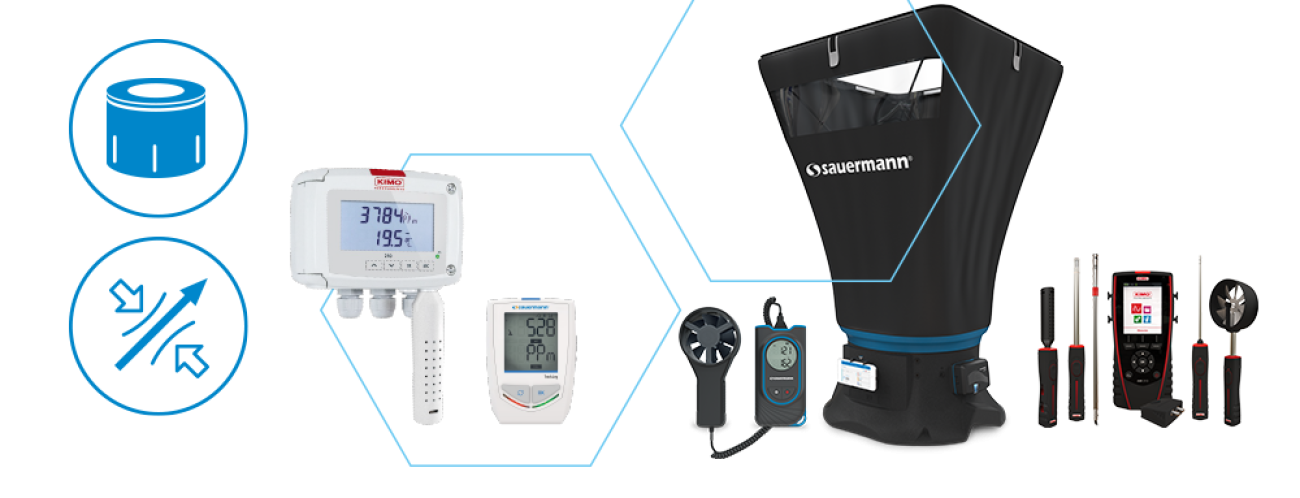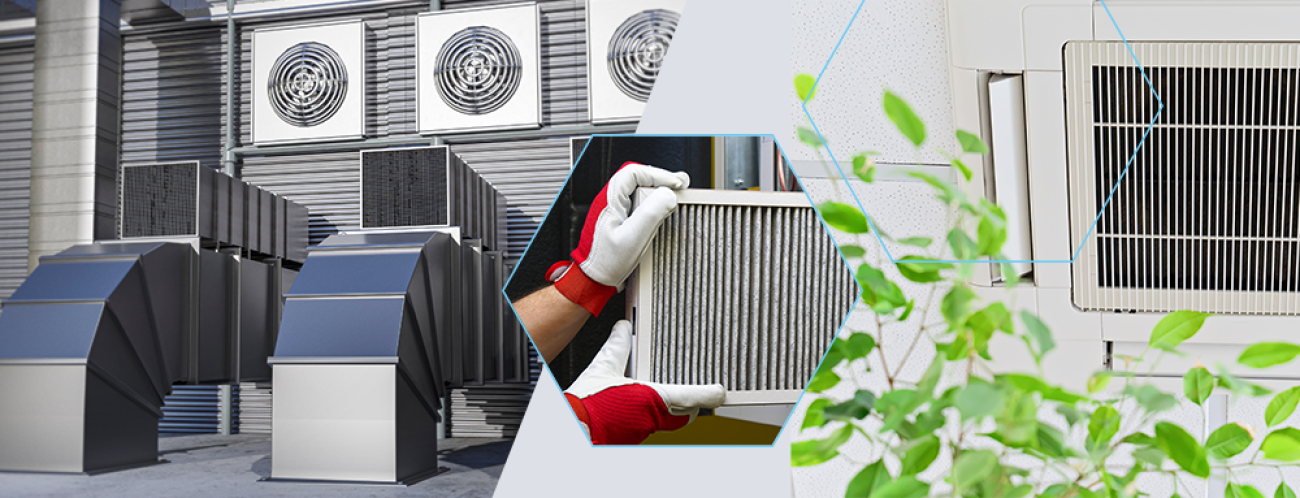VOCs: what they are, where they come from, and how to measure them

IAQ management has enjoyed a stratospheric rise through the ranks to become one of the most important disciplines in the world of buildings and ventilation. It plays a prominent role in addressing some of the key challenges of our times: tackling air pollution to protect the environment, combating bacterial and viral infections to preserve public health, and keeping us comfortable in an age when we spend most of our lives indoors.
VOCs are among the prime targets for IAQ professionals, alongside viruses, bacteria, particles and certain gases, which can become toxic at excessively high concentrations. The aim is to keep airborne concentrations of these substances to a minimum. And the key weapon in this fight is something we’ve discussed at length in other INsights blog articles: the air change rate (or ACR for short), using CO2 concentration as a particularly effective indicator.
What are volatile organic compounds?
VOCs are a large group of chemicals that can easily be emitted as gases into the air. To qualify as a VOC, a substance has to be volatile – in other words, the molecules evaporate or sublimate under standard temperature, humidity, light (UV) and pressure conditions. The term therefore covers a relatively broad spectrum of compounds, whose origins can be either artificial (evaporation of solvents, chemicals, etc.) or natural (emitted by plants, through fermentation, etc.).
For IAQ professionals, the most important VOCs are chemicals that are easily emitted as gases under ambient conditions, thereby building up in the air inside a building. The main sources of these substances are as follows:
- Cleaning and maintenance products: certain household products, such as detergents, cleaning products and air fresheners.
- Building and finishing materials: certain materials such as paints, varnishes, adhesives and carpets.
- Furniture and household items: certain objects such as mattresses, cushions and toys.
- Electronic devices such as printers and computers.
- Heating equipment such as ovens and wood-burning stoves.
- Activities such as smoking, cooking and welding.
Although each of these sources only emits tiny quantities of VOCs, the build-up of these compounds from different origins can leading to worryingly high overall concentrations – expressed as total volatile organic compounds, or TVOCs – in indoor air.

Among the many VOCs found in the atmosphere, those listed below are among the most commonly encountered in the world of IAQ:
- Formaldehyde: a colourless, irritant gas that can be emitted by certain building and finishing materials such as adhesives, as well as by some electronic devices and heating equipment.
- Tetrachloroethylene (or perchloroethylene): a gas emitted by solvents used for dry cleaning of various materials. It’s a particularly harmful substance – a carcinogen that can also cause brain, kidney and liver damage.
- Benzene: this gas is emitted by some paints, varnishes and other finishing products, and is also released through the burning of tobacco, candles, incense, etc.
- Acetaldehyde: this substance can be released in tobacco smoke, as well as from equipment such as photocopiers and some insulating materials.
- Dichloromethane: this solvent is typically emitted by all kinds of lacquers, glues and adhesives.
- Toluene: a gas released by certain solvents, generally paint thinners, as well as some electronic devices and heating systems.
- Trichloroethylene: a gas emitted by certain maintenance products such as grease removers and dry cleaning chemicals.
- Acetone: a solvent released by certain cleaning products and cosmetics, as well as by some electronic devices.
- Ethylene glycol: a gas emitted by certain heating and cooling systems, as well as by some cleaning products.
- Methanol: a gas released by certain cleaning products, electronic devices and heating systems.
- Xylene: a gas that evaporates from some solvents, such as paint thinners, as well as from certain electronic devices and heating systems.
- Trichloroethane: a gas emitted by certain household products such as grease removers and dry cleaning chemicals.
Are VOCs toxic?
Given the sheer size of VOCs as a group, it’s hard to make generalisations. But many VOCs can be harmful to health. The effect varies according to VOC type, concentration and exposure time. Once again, the real problem stems from a build-up of multiple VOCs in a poorly ventilated room.
The potential harm caused by VOCs also varies dramatically between individuals. Some people will experience symptoms more quickly than others, or will be more susceptible to the harmful health effects of particular compounds. Here too, it’s important to think about the risk posed by VOCs holistically, which implies monitoring all such compounds accumulated in the air and considering their combined potential toxicity to the exposed population as a whole.
The effects of VOCs also vary significantly, from benign symptoms such as fatigue and irritation of the eyes, airway and skin, to serious problems such as cancer and respiratory problems following prolonged exposure.
As we explain in this article, the danger thresholds for concentrations of TVOCs are as follows (expressed in parts per billion):
| Optimal level | Monitoring required | Dangerous level | |
|---|---|---|---|
| TVOC | 0 – 300 ppb | 300 – 750 ppb | > 750 ppb |
In short, the risks posed by VOCs are just as volatile as the compounds themselves!

Can VOC concentrations be measured?
Measuring VOC concentrations in ambient air requires advanced, highly specialised instruments. Although such instruments are rare, most IAQ specialists will have them. These gas analysers are designed to measure concentrations of common VOCs in the air, including the most common of all: formaldehyde (also known as methanal or formic aldehyde, chemical symbol: CH2O).
Sauermann’s IAQ monitoring range includes a number of instruments that, to differing degrees, can measure concentrations of VOCs as well as other gases:
| Si-AQ Pro | Si-AQ VOC Monitor | Si-AQ Expert |
|---|---|---|
| CH2O (formaldehyde) |
CH2O (formaldehyde) COV low and high scales |
CH2O (formaldehyde) COV low and high scales |
Measuring TVOCs on low and high scales provides an indication of all VOCs, on both a highly sensitive scale expressed in parts per billion (0–20,000 ppb) and a larger scale expressed in parts per million (0–200 ppm).
How to protect against VOCs
The best way to protect against VOCs is to act early: prevention is always the best option. There are several easy ways to avoid these compounds building up in the ambient air and to reduce their concentrations.
As with other types of indoor air pollution, the most reliable and effective method is to make sure the space is well-ventilated: regularly let fresh air into the room to dilute VOC concentrations, or make sure the building’s ventilation system guarantees a sufficient ACR. Ventilation system professionals routinely check the ACR, using instruments such as the DBM 620 air flow meter and portable anemometers to adjust the air flows into and out of a room, taking into account the total volume of the space, how many occupants are inside and what they’re doing.
While intense physical exercise can release varying quantities of CO2 into the air, other professional and business-related activities can also emit VOCs, depending on what equipment is in the room and how it’s being used. Some mission-critical production and storage areas will therefore require a higher ACR than basic office spaces.

While the ACR is important, it’s also essential to make sure that the ventilation system is fitted with high-quality air filters. The particles that build up in clogged filters could potentially release VOCs into every room in a building. This contagion risk can be reduced by keeping the air filters under constant watch with differential pressure transmitters, so that any filters that become clogged can be replaced with new ones.
Other behavioural measures can also help to keep indoor VOC concentrations to a minimum. The first and most important is not to smoke indoors! Cigarette smoke contains high concentrations of VOCs of all types, some of which are extremely toxic. It’s also advisable to avoid using cleaning and maintenance products containing large amounts of chemicals, and to opt for more natural alternatives instead. During building and renovation work, it’s recommended to use materials, paints, adhesives and varnishes with low VOC concentrations. The same goes for cosmetics: choose acetone-free nail polish remover, and opt for hairsprays and other beauty products that contain as few chemicals as possible. That’s why it’s so important to maintain adequate indoor air change in beauty and hair salons – especially for the people who work there, who are exposed to these types of products all day long.





Add new comment